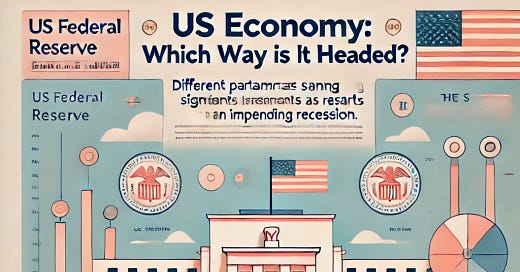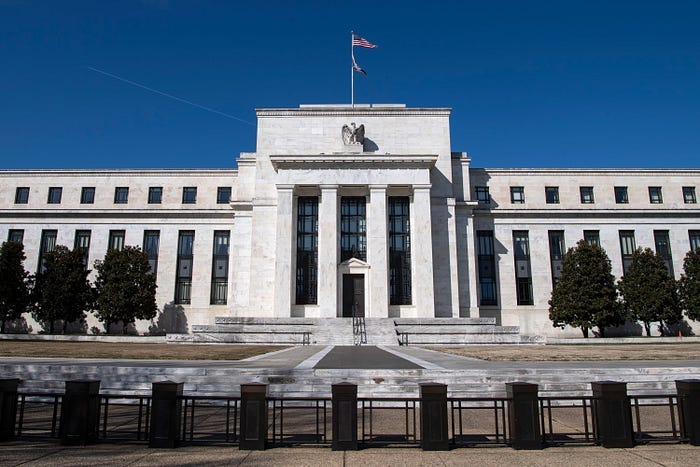US Economy: Which Way is it Headed?
Different parameters are sending divergent signals as regards an impending recession.
Overview of the Current State of the US Economy
As we progress through 2024, the US economy is navigating a period of mixed signals and uncertainties. While some sectors show resilience and growth, others are experiencing notable slowdowns. The labor market, inflation trends, consumer spending patterns, and stock market reactions all paint a diverse picture of the economic landscape. These dynamics highlight the complexity of the current economic environment, necessitating careful analysis and informed decision-making by policymakers and stakeholders to steer the economy towards stability and sustained growth.
a.) Unemployment and Job Market
The unemployment rate in the United States rose to 4.3% in July 2024, up from 4.1% in June. This marks the highest unemployment rate since October 2021. Nonfarm payrolls increased by only 114,000 in July, significantly lower than the expected 185,000 job additions, indicating a notable slowdown in job growth compared to previous months.
b.) Inflation
The annual inflation rate for the United States was 3% for the 12 months ending June 2024, down from 3.3% in the previous month. This demonstrates a continued moderation in inflation, although it remains above the Federal Reserve's 2% target.
c.) Consumer Spending and GDP
Consumer spending, which accounts for nearly 70% of economic activity, grew by 2.3% year-over-year, adjusted for inflation, in the second quarter of 2024. This reflects higher spending on both goods (up 2.5%) and services (up 2.2%). The US economy showed resilience in the second quarter, with GDP growth rebounding to an annual rate of 2.8%, surpassing expectations of 2%.
d.) Stock Market Reaction
The stock market reacted negatively to the latest economic data:
On Thursday, August 1, 2024, the Dow Jones Industrial Average dropped 345 points (0.9%), the S&P 500 fell 1.4%, and the Nasdaq Composite slid 2.4%.
On Friday, August 2, 2024, the Dow plummeted nearly 1,000 points, down 1.51%, while the tech-heavy NASDAQ plummeted 2.43%, indicating significant market concern about the economic outlook.
Year-over-Year Comparisons
GDP Growth: 2.1% for the first six months of 2024, showing steady growth.
Retail Sales: Up 2.8% for the first six months of 2024 compared to the same period in 2023.
Disposable Personal Income: Rose 3.6% year-over-year in Q2 2024, down from 4.8% in Q1.
Recession Concerns
While the economy has shown resilience, there are growing concerns about a potential recession. The rise in unemployment, slowing job growth, and negative market reactions suggest increased economic uncertainty. However, it's important to note that consumer spending and GDP growth remain positive, which could help prevent a severe downturn.
Predicting Recession: The Sahm Rule Explained
The Sahm Rule is a recession indicator developed by economist Claudia Sahm in 2019. This rule signals the start of a recession when the three-month moving average of the national unemployment rate (U3) rises by 0.50 percentage points or more compared to its lowest point in the previous 12 months. It is based on historical observations that significant rises in unemployment often indicate the onset of a recession. Key features of the Sahm Rule include its simplicity, as it uses readily available unemployment data, timeliness in reflecting the initial stages of a recession, and historical accuracy, having never triggered outside of a recession since the 1970s.
Current Situation and Sahm's Perspective
As of August 2024, the Sahm Rule indicator is close to triggering, with a current reading of 0.53% according to Federal Reserve data. However, Claudia Sahm herself cautions against interpreting this as a definitive recession signal. She highlights unusual labor market conditions, such as mixed signals in the labor market data and a significant deviation between the household survey (on which the unemployment rate is based) and the establishment survey of workplaces.
Additionally, data collection issues, including declining response rates to labor market surveys since the COVID-19 pandemic, have affected data quality, particularly in the household survey. Despite the rise in unemployment, job creation remains robust, which is atypical for the start of a recession. Sahm emphasizes that her rule was designed as a timely indicator that a recession might already be underway, not as a predictive tool for future recessions.
Implications for Federal Reserve Policy
The mixed economic signals present a challenge for the Federal Reserve as it considers potential rate cuts:
Moderating inflation (3% in June) may give the Fed room to consider rate cuts.
Rising unemployment (4.3% in July) could pressure the Fed to ease monetary policy.
Resilient consumer spending and GDP growth may cause the Fed to be cautious about cutting rates too quickly.
Federal Reserve Board member Christopher Waller recently stated that while inflation data is encouraging, he wants to see "a bit more evidence" before considering rate cuts. The next Fed meeting is scheduled for September, and the current economic situation suggests that a rate cut could be on the table, though it's not guaranteed.
Year-over-Year Comparisons
GDP Growth: 2.1% for the first six months of 2024, showing steady growth.
Retail Sales: Up 2.8% for the first six months of 2024 compared to the same period in 2023.
Disposable Personal Income: Rose 3.6% year-over-year in Q2 2024, down from 4.8% in Q1.
Looking Forward
In summary, while the US economy is showing some signs of slowing, particularly in the job market, it has maintained growth in key areas like consumer spending and GDP. The Federal Reserve will need to carefully balance these factors when deciding on interest rate policy in September. Different parameters are sending divergent signals regarding an impending recession.
As the nation heads toward the presidential election on 5th November, with the margin between Donald Trump and the reinvigorated Democratic Party with Kamala Harris as the presumptive candidate, the impact of the September decision could have far-reaching political ramifications. These implications extend beyond merely a spike upwards or downwards in the stock markets, as the domestic economy continues to be a dominant factor in American electoral politics.
Citations
[1] https://www.usinflationcalculator.com/inflation/current-inflation-rates/
[2] https://www.bls.gov/news.release/pdf/empsit.pdf
[5] https://nrf.com/research/monthly-economic-review-august-2024
[6] https://www.cnbc.com/2024/08/01/stock-market-today-live-updates.html
[8] https://tradingeconomics.com/united-states/unemployment-rate





